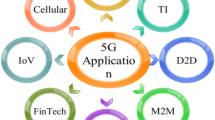Abstract
In this paper, we propose an oversampled WiMAX receiver as an attempt to improve throughput of WiMAX system. In communication, oversampling is a technique that a signal is sampled with a higher sampling frequency than its original bandwidth at the receiver side. Thus more signal sequences, which is received through different paths, may be obtained compare to system with conventional sampling. These additional sequences generate diversity. This study theoretically analyzes an oversampled wireless communication system in case of capacity with outage over Rayleigh distributed flat fading channel and presents throughput of the oversampled WiMAX receiver that obtained by simulation over a realistic channel model and by experimental tests. Since the performance of an oversampled system very much depends on the channel conditions, realistic channel model and experimental study are essential to exhibit realistic performance benchmarks. Theoretical analyzes, simulations and experimental results clearly show that the oversampled receiver significantly outperforms the spectrum efficiency of the communication system.









Similar content being viewed by others
References
IEEE Std. 802.16TM-2004, Part 16: Air interface for fixed broadband wireless access systems (2004, October).
Chen, B., & Wang, H. (2004). Blind estimation of OFDM carrier frequency offset via oversampling. IEEE Transactions on signal Processing, 52, 2047–2057.
Sharif, M., Alkhansari, M. G., & Khalaj, B. H. (2003). On the peak-to-average power of OFDM signals based on oversampling. IEEE Transactions on Communications, 51, 72–78.
Rong, L., Zhi, X., & Xue, Y. (2008). Low-complexity PAPR reduction of MC-SS signals in PAN. Wireless Personal Communications, 45(2), 175–188.
Shi, Q., Guan, Y. L., Gong, Y., & Law, C. L. (2009). Receiver design for multicarrier CDMA using frequency domain oversampling. IEEE Transactions on Wireless Communications, 8, 2236–2241.
Lee, Y. S., & Seo, B. S. (2009). OFDM receivers using oversampling with rational sampling ratios. IEEE Transactions on Consumer Electronics, 55, 1765–1770.
Wu, J., & Zheng, Y. R. (2011). Oversampled orthogonal frequency division multiplexing in doubly selective fading channels. IEEE Transactions on Communications, 59, 815–822.
Goldsmith, A. (2005). Wireless communication (1st ed.). Cambridge: Cambridge University Press.
Turin, G. L., Clapp, F. D., Johnston, T. L., Fine, S. B., & Lavry, D. (1972). A statistical model of urban multipath propagation. IEEE Transactions on Vehicular Technology, 21, 1–9.
Tse, D. (2005). Fundamentals of wireless communication (1st ed.). Cambridge: Cambridge University Press.
Proakis, J. (2001). Digital communication (4th ed.). New York: McGraw-Hill.
Miao, G. J. (2007). Signal processing in digital communications (1st ed.). Boston, MA: Artech House.
Falconer, J., Ariyavisitakul, S. L., Seeyar, A. B., & Eidson, B. (2002). Frequency domain equalization for single carrier broadband wireless systems. IEEE Communication Magazine, 40, 58–66.
Sebastio, P., Velez, F. J., Costa, R., Robalo, D., & Rodrigues, A. (2010). Planning and deployment of WiMAX networks. Wireless Personal Communications, 55(3), 305–323.
Andrews, J. G., Ghosh, A., & Muhamed, R. (2007). Fundamentals of WiMAX: Understanding broadband wireless networking. New Jersey: Pearson Education.
Recommendation ITU-R M.1225. (1997). Guidelines for Evaluation of Radio Transmission Technologies for IMT-2000.
Turk, K., & Kaya, I. (2008). Experimental BER performance evolution of equalizations and matched filter bounds for single-carrier WiMAX radio in 3.5 GHz. In IEEE Wireless Communication and Networking Conference (WCNC 2008) (pp. 2015–2020) Las Vegas, USA.
Hashemi, H. (1993). The indoor radio propagation channel. Proceedings of the IEEE, 81, 943–968.
Rappaport, T. S., Seidel, S. Y., & Takamizawa, K. (1991). Statistical channel impulse response models for factory and open plan building radio communicate system design. IEEE Transactions on Communications, 39, 794–807.
Das, S. S., Carvalho, E. D., & Prasad, R. (2008). Performance analysis of OFDM systems with adaptive sub carrier bandwidth. IEEE Transactions on Wireless Communications, 7(4), 1117–1122.
Author information
Authors and Affiliations
Corresponding author
Additional information
This work was supported by Karadeniz Technical University Scientific Research Council Project Number 2010.112.004.2.
Rights and permissions
About this article
Cite this article
Turk, K. Throughput Evaluation of Oversampled Receiver: An Example of WiMAX System. Wireless Pers Commun 79, 279–292 (2014). https://doi.org/10.1007/s11277-014-1856-2
Published:
Issue Date:
DOI: https://doi.org/10.1007/s11277-014-1856-2




